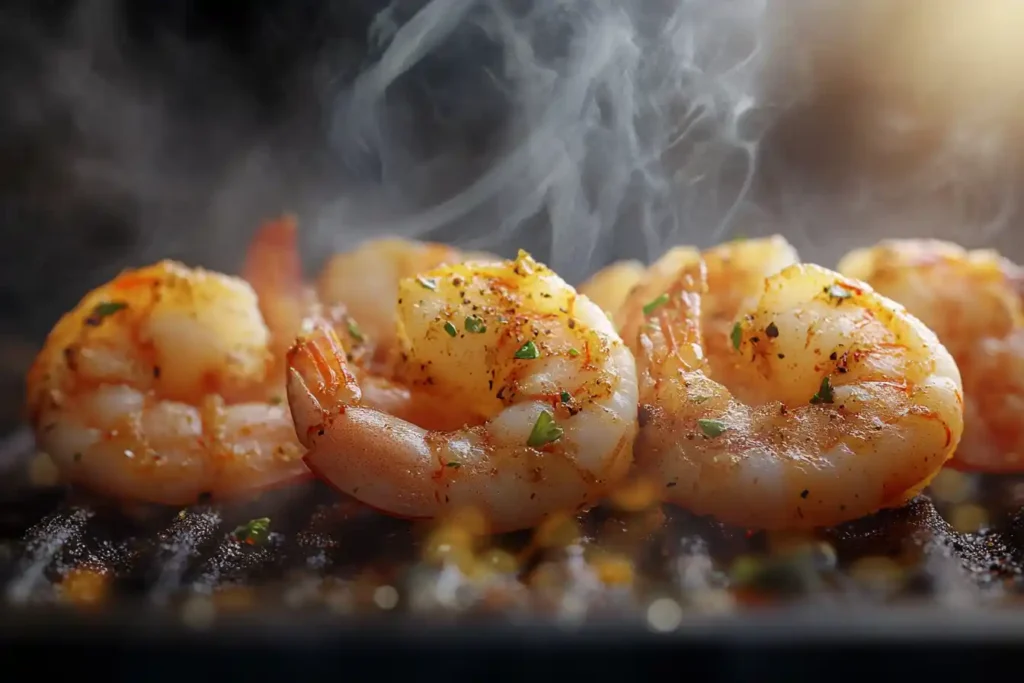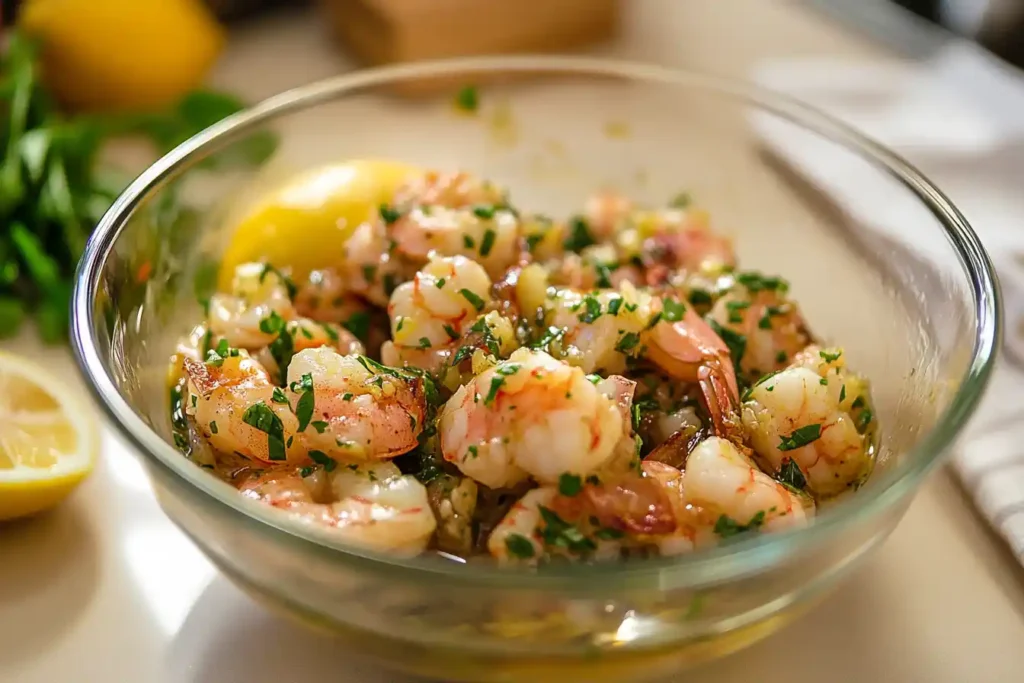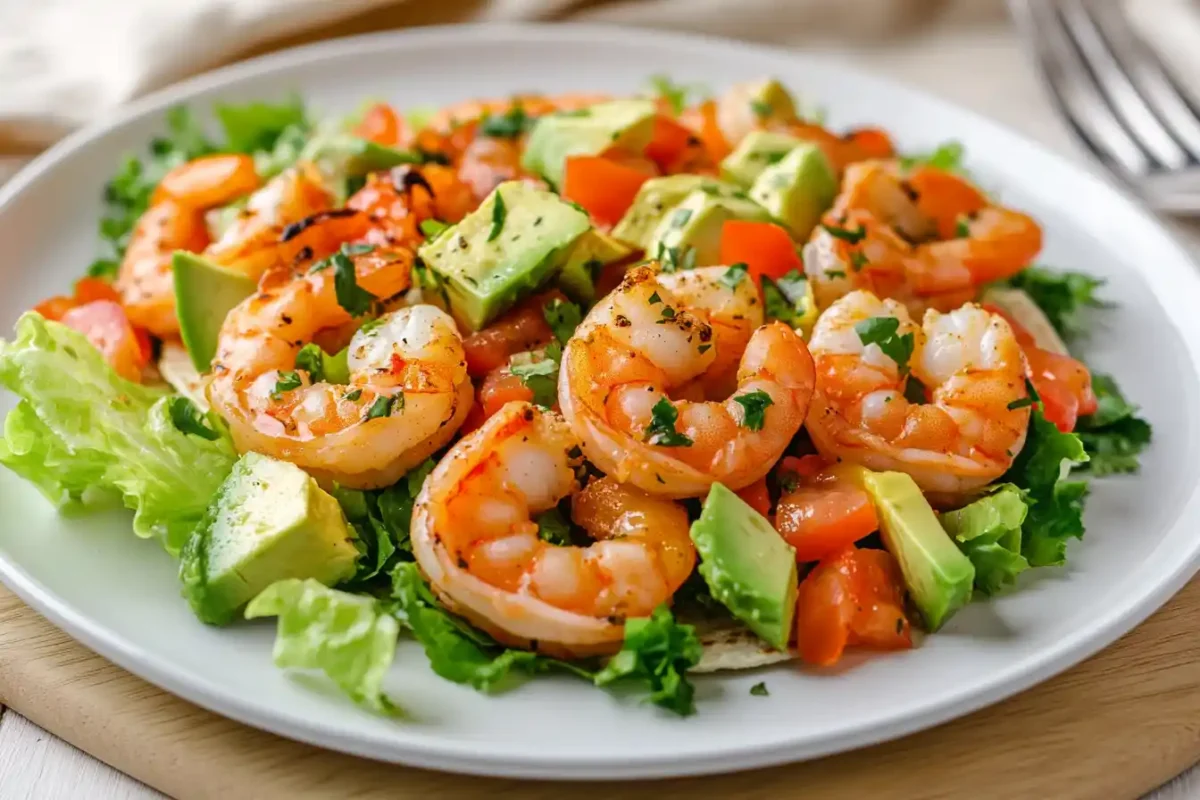Understanding Shrimp Anatomy
The Role of Shrimp Shells in Cooking
Shrimp shells act as a heat barrier, protecting the meat during cooking and locking in moisture. As they char, they release smoky notes that enhance flavor. This makes shell-on shrimp juicy and flavorful even under high heat.
How Shrimp Shells Affect Cooking Times
Shell-on shrimp cook slower than shell-off shrimp, reducing the risk of overcooking, which is helpful for beginners. Shell-off shrimp, however, cook faster, requiring careful timing to avoid dryness.
When Does the Shell Get in the Way?
While shells retain moisture, they block marinades from fully penetrating the meat. Shell-off shrimp absorb seasoning better, but oil-based marinades can still infuse flavor into shell-on shrimp effectively.
Flavor Implications

How Shell-On Shrimp Enhances Flavor
Shell-on shrimp trap juices during cooking, creating a steaming effect that enhances sweetness and tenderness. Slight charring on the shell adds a smoky aroma, delivering a rich, layered flavor perfect for seafood lovers. The shell also retains the shrimp’s brininess and prevents dryness, offering a flavor profile shell-off shrimp can’t match.
Shell-Off Shrimp and Seasoning Absorption
Without the shell, shrimp absorb marinades and spices more effectively, resulting in bold, intensely flavored meat. However, shell-off shrimp are prone to drying out, so quick grilling and frequent basting help maintain moisture.
Balancing Flavor with Texture
Shell-on shrimp provide a smokier, richer taste, while shell-off shrimp excel in recipes emphasizing seasoning. For the best of both worlds, grill with the shell on and remove it before serving to retain juiciness and flavor.
Moisture and Texture Considerations
Shell-On Shrimp as a Moisture Barrier
One of the greatest perks of grilling shrimp with the shell on is how effectively the shell locks in moisture. The natural barrier acts like a protective coat, ensuring the shrimp doesn’t lose its juices while exposed to high grill temperatures. This technique results in succulent, plump shrimp that are perfectly tender inside, even if cooked for a little longer than ideal.
As the shell chars, it not only adds a smoky flavor but also creates a slight steaming effect. This keeps the interior meat from drying out, making shell-on shrimp an excellent choice for beginners or for grilling at high temperatures. It’s almost like the shell works double duty—preserving the texture while imparting a subtle crunch to the exterior.
How Shell-Off Shrimp Impacts Texture
Grilling shrimp without the shell produces a very different result. Without the protective layer, the meat is directly exposed to the heat, allowing it to crisp up and caramelize more easily. This creates a firmer texture and slightly crispy edges that some people find irresistible. It’s perfect if you’re aiming for that slight char or golden crust that enhances the visual and textural appeal of the dish.
That said, shell-off shrimp can quickly go from tender to rubbery if left on the grill too long. Since the exposed surface has no moisture-locking barrier, precise timing and careful attention are critical to achieve the right balance of texture without overcooking.
Why Texture Matters in Shrimp Dishes
The texture of shrimp can make or break a dish. Shell-on shrimp tend to have a softer, juicier bite, making them ideal for dishes where the natural flavor and moist texture are central. In contrast, shell-off shrimp’s slightly firmer and drier texture pairs well with heavily seasoned or crispy dishes, like shrimp tacos or salads.
Ultimately, your choice between shell-on and shell-off shrimp depends on the desired texture for your barbecue. If you’re craving succulent, moist bites, go for the shell-on method. But if you prefer a firmer, slightly charred texture, shell-off shrimp is your best bet.
Cooking Techniques for Shell-On Shrimp
Preparing Shell-On Shrimp for the Grill

Grilling shrimp with the shell on starts with proper preparation. First, rinse the shrimp thoroughly under cold water to remove any grit or debris. While the shell stays on, you might still want to devein the shrimp for a cleaner presentation and improved flavor. To do this, make a shallow slit along the back of the shrimp with a sharp knife, then gently remove the dark vein.
For seasoning, opt for oil-based marinades. These cling to the shell’s surface and infuse the meat as it cooks. A mixture of olive oil, garlic, lemon juice, and your favorite spices works beautifully, as shown in this BBQ shrimp recipe. Allow the shrimp to marinate for at least 20–30 minutes before grilling to enhance the flavor.
Grilling Shell-On Shrimp Like a Pro
When grilling shell-on shrimp, the key is to use medium-high heat.Start by preheating your grill and lightly oiling the grates to prevent sticking for the best way to barbecue shrimp. Arrange the shrimp in a single layer, making sure there’s enough space between them to cook evenly. Grill for about 2–3 minutes per side or until the shells turn a vibrant pink and have slight char marks. Avoid overcooking—once the shrimp are opaque inside, they’re ready.
One trick to get the best flavor is basting the shrimp with your marinade while grilling. This not only locks in moisture but also adds an extra layer of flavor to the shell. Flip the shrimp only once to ensure even cooking without disrupting the natural juices.
Serving Shell-On Shrimp
Shell-on shrimp are perfect for casual, hands-on meals where guests peel the shrimp themselves. Serve them hot off the grill with dipping sauces like garlic butter or a zesty citrus aioli. The process of peeling shrimp at the table adds to the dining experience, as do great seafood presentation tips.making the meal more interactive and enjoyable.
Cooking Techniques for Shell-Off Shrimp
Preparing Shell-Off Shrimp for the Grill
To grill shell-off shrimp, rinse and pat them dry carefully to avoid tearing the meat. Marinate for 15–20 minutes using bold flavors like soy sauce or citrus juice. Skewer the shrimp to prevent sticking or falling through the grates, and soak bamboo skewers beforehand to avoid burning.
Grilling Shell-Off Shrimp with Precision
Cook shrimp over medium heat for 1–2 minutes per side until they turn pink and opaque. Avoid overcooking, as the exposed meat is delicate. Baste with marinade for added flavor and watch for flare-ups if using sugary marinades.
Serving Shell-Off Shrimp
Shell-off shrimp are ideal for convenience, perfect for tacos, pasta, or platters. Serve with fresh herbs, grilled vegetables, and a tangy sauce to enhance their smoky flavor.
Both methods have unique advantages, but marinades and seasonings play a key role in determining the outcome. Up next, let’s explore seasoning strategies!
Marination and Seasoning Strategies
Best Marinades for Shell-On Shrimp
Marinating shell-on shrimp is easier with oil-based marinades, as they cling to the shell and seep into the meat while grilling. Olive oil, garlic, lemon zest, paprika, and cayenne work well to infuse smoky and zesty flavors. Limit marination to 20–30 minutes and avoid acidic ingredients, which can weaken the shells.
Best Marinades for Shell-Off Shrimp
Shell-off shrimp absorb marinades directly, making them ideal for bold flavors. Citrus-based blends with lime, cilantro, and chili, or soy sauce with honey and ginger, add sweetness and depth. Marinate for 15–20 minutes and baste during grilling for added flavor.
Seasoning Tips for Both Methods
Dry rubs are versatile for both shell-on and shell-off shrimp. A mix of smoked paprika, garlic powder, and salt creates a savory crust. For shell-on shrimp, ensure the shell is dry before applying; for shell-off, coat generously and let it rest for 10 minutes.
Experiment with seasonings to suit your taste, and enjoy the unique advantages of each method. Up next, let’s cover health and safety considerations!
Health and Safety Considerations
Grilled shrimp nutritional content per 100 grams
| Nutrient | Amount |
|---|---|
| Calories | 99 kcal |
| Protein | 24 g |
| Fat | 0.3 g |
| Carbohydrates | 0 g |
| Cholesterol | 189 mg |
| Sodium | 111 mg |
Cooking Shrimp to Safe Temperatures
Properly cooked shrimp are not only delicious but also safe to eat. The USDA recommends cooking shrimp to an internal temperature of 145°F. For those grilling, this translates to cooking until the shrimp turns opaque with a slightly pink hue. Shell-on shrimp often provide visual cues, as the shell will turn a bright red or orange when fully cooked. For shell-off shrimp, ensure the flesh is no longer translucent.
Avoid undercooking shrimp, as it can harbor bacteria like Vibrio. On the flip side, overcooked shrimp can become tough and chewy, making them less enjoyable to eat. Always use a food thermometer for accuracy, especially when cooking for large groups or outdoor events.
Proper Cleaning and Handling of Shrimp
Cleanliness is crucial when working with shrimp. Start by rinsing them under cold water to remove any sand or debris. If you’re grilling shrimp with the shell on, consider deveining them by making a shallow slit along the back and removing the vein. For shell-off shrimp, ensure the vein is removed entirely for a cleaner flavor.
When handling raw shrimp, avoid cross-contamination by washing your hands, cutting boards, and utensils thoroughly. Always refrigerate shrimp if you’re not grilling them immediately, and never leave them at room temperature for more than two hours.
Allergen Awareness and Precautions
It’s worth noting that shrimp are a common allergen. If you’re hosting a barbecue, inform guests about the inclusion of shrimp in the menu to prevent any unexpected allergic reactions. Keeping shell-on shrimp separate from other proteins can also help reduce the risk of cross-contact.
Cultural and Regional Preferences
Shell-On Shrimp in Global Cuisines
In many cultures, shell-on shrimp is a celebrated choice. Southeast Asian cuisines often serve grilled shell-on shrimp with bold flavors like lemongrass, chili, and lime, highlighting their natural taste. Similarly, Mediterranean dishes embrace shell-on shrimp for their rustic appeal, often seasoned with olive oil and herbs before grilling. These cultural approaches emphasize the shrimp’s authenticity and make peeling part of the dining experience.
Shell-Off Shrimp in Culinary Traditions
Shell-off shrimp is favored in cuisines that prioritize convenience and seasoning absorption. In American barbecue culture, shell-off shrimp is often marinated with smoky spices and served in tacos, salads, or skewers. Shell-off shrimp also dominate in stir-fry dishes, where quick cooking and seamless seasoning integration are key.
Environmental and Sustainability Factors
Sustainable Shrimp Choices
Sustainability plays a crucial role in shrimp selection, whether grilling shell-on or shell-off. Farmed shrimp can have environmental impacts if not responsibly sourced, while wild-caught shrimp can harm marine ecosystems if caught with destructive practices. Always look for certifications like MSC (Marine Stewardship Council) or ASC (Aquaculture Stewardship Council) labels to ensure your shrimp is sustainably harvested.
Supporting Local and Eco-Friendly Suppliers
Buying from local seafood markets not only supports your community but often ensures fresher, more eco-conscious options. Ask vendors about their sourcing practices to make informed choices that align with sustainability goals.
Cost and Availability
Comparing Prices of Shell-On and Shell-Off Shrimp
Shell-on shrimp tend to be more affordable because they require less processing. However, they may take extra effort to prepare and eat. Shell-off shrimp, though pricier, save time and are often more convenient for quick meals or large gatherings.
Availability in Local Markets
Both types of shrimp are widely available, but regional preferences can influence availability. Coastal areas may offer fresh, local shrimp in both forms, while inland markets might rely more on frozen or pre-packaged options. Check your local seafood section or specialty stores for the best selection.
Frequently Asked Questions About Barbecue shrimp with shell on or off
It depends on your preference. Shell-on prawns retain moisture and have a smokier flavor, while shell-off prawns absorb seasoning better and are easier to eat.
Yes, the shell traps natural juices and adds a smoky, umami flavor when grilled. It also prevents the shrimp from drying out during cooking.
Steaming with the shell on is better for retaining moisture and enhancing the natural taste, while shell-off shrimp absorb more seasoning during steaming.
Cooking with the tail on adds presentation value and enhances flavor. It can also serve as a natural handle for eating. However, removing the tail is more convenient for some recipes.
Conclusion Barbecue shrimp with shell on or off
Deciding whether to barbecue shrimp with the shell on or off ultimately depends on your priorities—flavor, texture, convenience, or presentation. Shell-on shrimp lock in moisture and provide a rich, smoky taste, making them ideal for authentic barbecues. On the other hand, shell-off shrimp excel in dishes requiring bold seasonings and are easier to eat, especially in tacos, salads, or pasta.
By understanding the nuances of each method, you can tailor your approach to suit the occasion and your personal preferences. Whether you choose shell-on or shell-off, grilling shrimp is an opportunity to create a flavorful and satisfying dish every time. So, fire up the grill, try both methods, and let your taste buds decide the winner!

